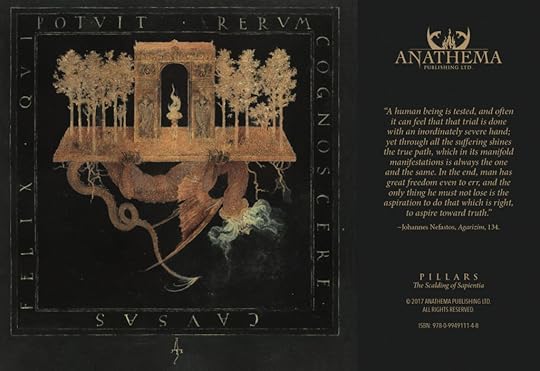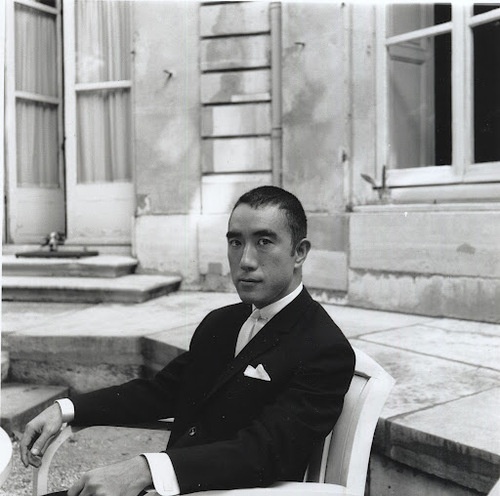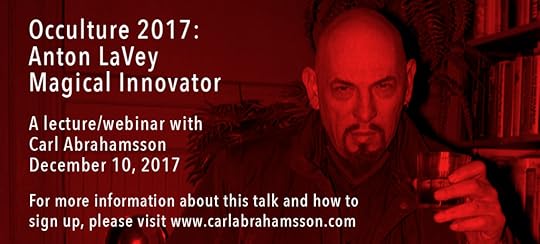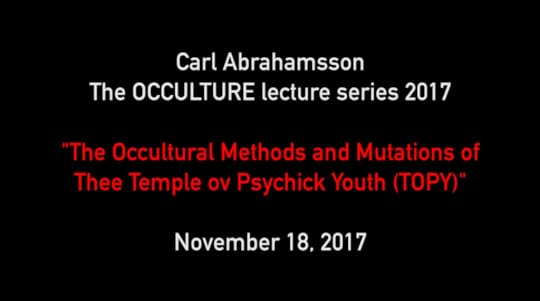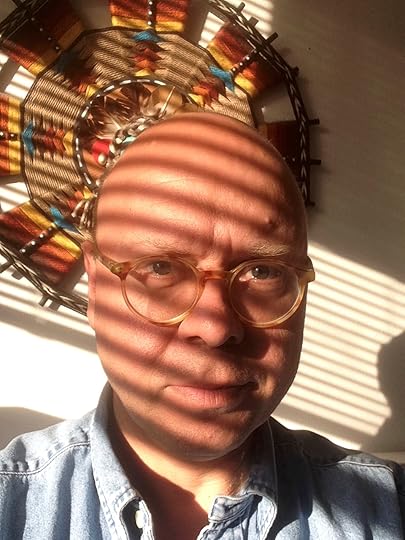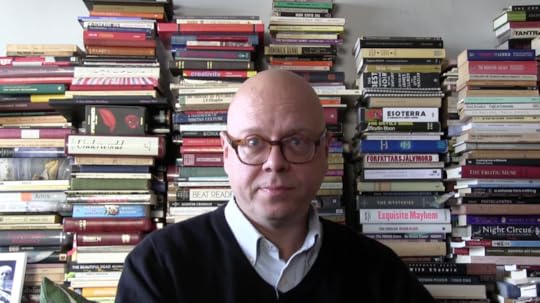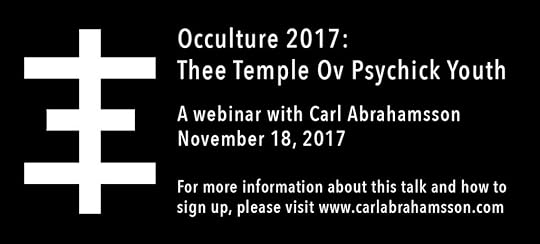Carl Abrahamsson's Blog, page 58
December 12, 2017
The Mega Golem keeps on moving
I have a piece about my magical four-dimensional talismanic art project, the MEGA GOLEM, in the upcoming book Pillars. Please find enclosed some information right here:
“Of all the daimons that have plagued or blessed mankind throughout history, our muse, Wisdom, is perhaps the most elusive of all. Known by many names and terms – Gnosis, Sapientia, Sophia, and Lucifer, among many others – this varied and challenging topic is difficult to discuss using mere semantics; so liquid are Its inherent qualities and so fierce is Its passion!
“This spirit-force represents every manifested Idea and Ideal, be they creative intelligence or a self-annealing process that guides the pilgrim along the Path of Exile & Exalt. As a “living” and moving ethos/archetype/notion, Sapientia itself (regardless of chosen deific or prosaic name for it), is truly a discarnate entity. Its secrets are revealed simply, poignantly, and profoundly, but this gift comes at a certain price – a heavy and oftentimes formidable one at that!
“The theme of this issue could not be more Luciferian in essence, as it stands on the very foundation of Luciferian praxis and applied tenets. In layman’s terms, it revolves around the concept and application of “Sacrifice” in the pursuit of Truth, to reach Henosis/Apotheosis with the Divine-Within.
“The Scalding of Sapientia is a compendium of personal operations, insights, viewpoints, journal entries and excerpts, detailed compilations and interpretations, notable turning points in ones occult journey, and specifically, the zeniths and nadirs one can experience when undertaking such a colossal mission that may come with realizations that may either make or break ones persona in the Cosmogony of the Possible.”
CONTRIBUTORS:
Denis Forkas Kostromitin, Sarah Sheil, Gabriel McCaughry, Robert W. Cook (Norot), Nukshean, Chris Undirheimar, Paul Waggener, Johnny Decker Miller,Verónica Rivas,,Mitchell Nolte, David S. Herrerías, Helene M. Arts, Ulric Gestumblindi’ Goding, Camelia Elias, Adrian Baxter, Craig Williams, Graeme de Villiers, Johannes Nefastos, Shani Oates, Cristian Drăghiciu (Vaenvs Obscvra), William Malone, Néstor Avalos, Carl Abrahamsson
Order your copy here: https://www.freewebstore.org/anathemapublishing/product_preview/p1525717_18067972.aspx.
November 30, 2017
A LaVey online lecture PR clip
OCCULTURE: ANTON LAVEY – MAGICAL INNOVATOR
Join me for a darkside trip into the Satanic mind of Anton LaVey – magical innovator!
When? Sunday, December 10, 2017, at 20-22 GMT+1 / 11am-1pm PST / 2-4pm EST / 19-21 GMT
After the lecture there will be an opportunity for a Q&A/discussion.
To take part of this online lecture/webinar, please send $18 via PayPal to: carl AT carlabrahamsson DOT com After you have paid, I will send you all the relevant information/links. The number of attendee “seats” is limited, so please act fast.
More on the OCCULTURE webinar/lecture series 2017:
Art, magic, and the occult have been intimately linked since our prehistoric ancestors created the first cave paintings some 50,000 years ago. As civilizations developed, these esoteric forces continued to drive culture forward, both visibly and behind the scenes, from the Hermetic ideas of the Renaissance, to the ethereal worlds of 19th century Symbolism, to the occult interests of the Surrealists. In this lecture/webinar series exploring “occulture” – the liminal space where art and magic meet – I reveal the integral role played by magic and occultism in the development of culture throughout history as well as their relevance to the continuing survival of art and creativity. Blending magical history and esoteric philosophy, I look at the phenomena and people who have been seminal in modern esoteric developments.
My book “Occulture – the unseen forces that drive culture forward” will be published by Inner Traditions in March 2018. Available for pre-order NOW!
To take a look at previous webinars and lectures, please visit:
November 29, 2017
A first clip/track from my new solo album
I’m currently finishing up my new solo album, called THE LARVAL STAGE OF A BOOKWORM. The album will be released by Highbrow Lowlife on January 18, 2018. This is the first little offering from the album: INSIDE YOU IS OUTSIDE ME. I hope you enjoy it.
Carl Abrahamsson: Inside you is outside me from Carl Abrahamsson on Vimeo.
November 26, 2017
November 25: Happy Death-day, Yukio Mishima!
”Mishima battles with the enigmatic force field between words as conveyors of morals and spiritual values and their equally seductive power to entertain. This process being very much extended to and in the public persona of Mishima himself. In this strange mix between aspiration, body building, and a romanticized death wish, Sun & Steel is like an intellectual tornado of both a highly refined (wish for) control and a desperation to overcome weakness in order to meet the inevitable on one’s own terms. It is a way of cheating death, yes, but only by tricking it ahead of time through one’s own design.”
From the chapter ”Tangible Evanescence” in my forthcoming book Occulture – The unseen forces that drive culture forward (Inner Traditions , March 2018, available on pre-order HERE!
November 20, 2017
OCCULTURE: An Anton LaVey webinar/lecture coming up
OCCULTURE: Anton LaVey – Magical Innovator
Already in The Satanic Bible, Anton LaVey had shown considerable creativity. Concepts like ”Psychic Vampire” and ”The Balance Factor” soon became household terms in America and the rest of the world. His description of the ritual space as an ”Intellectual Decompression Chamber” also hit home outside the strictly Satanic perimeters. As did the slightly later term ”Occultnik”, signifying a person who is lost within old structures of occultism without being able to see what’s really of use on a practical, material level. LaVey’s initial key works, The Satanic Bible and The Satanic Rituals, are great examples of creative appropriation and reformulation. But the two volumes of essays and maxims that followed much later, ie The Devil’s Notebook and Satan Speaks, genuinely contain the essence of LaVey’s wit and creativity. In these books, we find many fascinating topics: the integration of emotionally resonant music, stressing the ego, encouraging a sense of humour, artificial human companions, the total environment, a re-evaluation of slavery, the archetype of the villain, the third side of truth and much more. Join me for a darkside trip into the Satanic mind of Anton LaVey – magical innovator!
When? Sunday, December 10, at 20-22 GMT+1 / 11am-1pm PST / 2-4pm EST / 19-21 GMT
After the lecture there will be an opportunity for a Q&A/discussion.
To take part of this lecture/webinar, please send $18 via PayPal to: carl AT carlabrahamsson DOT com After you have paid, I will send you all the relevant information/links. The number of attendee “seats” is limited, so please act fast.
More on the OCCULTURE webinar/lecture series 2017:
Art, magic, and the occult have been intimately linked since our prehistoric ancestors created the first cave paintings some 50,000 years ago. As civilizations developed, these esoteric forces continued to drive culture forward, both visibly and behind the scenes, from the Hermetic ideas of the Renaissance, to the ethereal worlds of 19th century Symbolism, to the occult interests of the Surrealists. In this lecture/webinar series exploring “occulture” – the liminal space where art and magic meet – I reveal the integral role played by magic and occultism in the development of culture throughout history as well as their relevance to the continuing survival of art and creativity. Blending magical history and esoteric philosophy, I look at the phenomena and people who have been seminal in modern esoteric developments.
My book Occulture – the unseen forces that drive culture forward will be published by Inner Traditions in March 2018. You can preorder the book HERE!
The TOPY lecture/webinar is now online!
Art, magic, and the occult have been intimately linked since our prehistoric ancestors created the first cave paintings some 50,000 years ago. As civilizations developed, these esoteric forces continued to drive culture forward, both visibly and behind the scenes, from the Hermetic ideas of the Renaissance, to the ethereal worlds of 19th century Symbolism, to the occult interests of the Surrealists. In this lecture/webinar series exploring “occulture” – the liminal space where art and magic meet – I reveal the integral role played by magic and occultism in the development of culture throughout history as well as their relevance to the continuing survival of art and creativity. Blending magical history and esoteric philosophy, I look at the phenomena and people who have been seminal in modern esoteric developments.
The occultural methods and mutations of Thee Temple Ov Psychick Youth (TOPY) have left a legacy that continues to inspire. In this talk, I look back at my time working (1986-1991) with TOPYSCAN and TOPY Europe in collaboration with TOPYUK and TOPYUS. It was a magical, ultra-creative time that taught me many things as well as allowed me to share my own findings with others. TOPY was a unique experiment in occulture, and one that still resonates today. Join me for an illuminating ride through sigil magic, roto-rites, underground publishing, and much more.
OCCULTURE: The methods and mutations of Thee Temple Ov Psychick Youth (TOPY) from Carl Abrahamsson on Vimeo.
The original transmission included a Q&A session. If you would like to be part of upcoming live webinars/lectures and have the opportunity to ask questions and interact, please sign up for my newsletter at: carlabrahamsson.com
My book OCCULTURE – THE HIDDEN FORCES THAT DRIVE CULTURE FORWARD is published by Inner Traditions in March 2018.
Copyright © 2017 Carl Abrahamsson
November 19, 2017
webinar thanks!
My first webinar in the OCCULTURE lecture series (”The occultural methods and mutations of Thee Temple Ov Psychick Youth/TOPY”) was a great success and made me feel very inspired about the forthcoming ones. Thank you, everyone who attended! I will announce the next webinar very shortly. And I will make the TOPY lecture available at Vimeo On Demand soon too.
My book Occulture – the hidden forces that drive culture forward can be pre-ordered right HERE!
November 16, 2017
The Origins of the ”An Art Apart” book
The following text constitutes the foreword to my upcoming book An Art Apart. It’s been a long and winding road through different media but now it’s all on course and quite soon docking in the harbour of your mind (I hope).
An Art Apart
In early 2013, I was sitting in a hotel room in Tallinn, Estonia, staring at an insanely ugly orange coloured wall. I was there to supervise the printing of an art book, feeling quite miserable. The book didn’t interest me at all and yet I had promised to deal with it. The printing, of course, did not go well. What to do? Dive into escapism, of course! Any excuse I could find to distract myself was more than welcome. The closest thing at hand was a small point and shoot camera that I’d borrowed from my daughter. Ugly wallpaper, ugly fridge, ugly bed, snap, snap, snap… After that, I was so bored I decided to try and shoot some video of myself. Boredom-infused narcissism! After a moment of hesitation and embarrassing silence I started talking straight into the camera, as if it were a very small TV crew. The words that suddenly came out of me were those of a host or reporter talking about art. Not any kind of postmodern bullshit, like the images of the book I was there to supervise. But rather soulful, intelligent art created by exciting, radical and groundbreaking people. I stopped and played it back, realising I sounded like some kind of enthusiastic Richard Attenborough of the underground. I genuinely hated my voice but started loving the concept.
That moment became an epiphany that immediately got hold of me on deep levels. I’d previously written so much for magazines, papers and books but the print market seemed ever dwindling by the day. So why not use a video camera instead and go for it again? That is, just meeting interesting people, letting them tell their own story on their own terms and see what comes out of it. I realised I was on to a new obsession and immediately started making notes about whom to contact.
My best friend Henrik Møll was as enthusiastic as me about it, and luckily he worked as an editor for television and film. Supported by his technical expertise, I ventured into a frenzied state of mind and just shot, shot, and shot material in Sweden, Norway, the US and the UK. After dealing with close artist friends first, I drifted into unknown territories with new acquaintances. Suddenly I was up to ten shot films, and tried to define the project as such:
“Some artists create groundbreaking, radical, provoking, transcending, transgressing, mutating works of art that continuously change the culture we live in. What goes on in their minds? What motivates them? And why do they create in the first place? An Art Apart is a series of documentary portraits of artists whose creations and concepts have inspired thousands of people worldwide – who in turn take the ideas further and into new environments. An Art Apart examines these artists’ creative processes, emotions and stories in intimate and revealing conversations. From the most esoteric underground expressions to the mainstream culture we all share, An Art Apart shines the light on what art really is – or can be.”
As we were about to start editing the first film, Henrik died. That was a big blow. Not only because of the fact that he was my best friend, but also because he had all the knowledge I lacked as a pathological technophobe. I was very close to abandoning the entire project when mutual friends talked me into continuing. One of them being the very first interviewee in the series, British artist Andrew McKenzie. At Henrik’s funeral in Copenhagen in August of 2014 I promised the assembled folks that each film would be dedicated to his loving memory.
Andrew has skills. A lot of them. Thank God. So we just daringly jumped into editing and trying to figure out how to actually go about making documentaries. And then, one by one, the films started appearing. During 2015 I was Sweden’s most productive filmmaker, with five documentaries, one art film (a tribute to experimental British filmmaker Derek Jarman) and one feature length psychological thriller under the belt. Some extra manic energy, support from the film gods and a devoted team of two can definitely get you a long way.
Then came that dreaded moment in time and space that most creative people don’t really like to think about: selling the product. I have always evaded and avoided this and did so again with these films. So much incredibly boring work to deal with. Not for me, no thanks. Although some of the films probably have real potential, I instead retracted to the safe haven of pen and paper (costs nothing, great joy, solitude, no technical gobbledegook). After a full circle jam-packed with cinematic hubris and many adventures in art-land I was back at square one: poor and in debt, slightly disgruntled but basically quite happy that I had at least tried it.
That was the short story of why this book exists. The films I actually finished have had very little outreach, and yet the minds and material of all these people I’ve met are so inspiring I feel they just have to be out there in tangible form. Now they are, and the concoctions are still dedicated to the loving memory of Henrik Møll.
Carl Abrahamsson, Stockholm, 2017
Featured artists: Andrew McKenzie/The Hafler Trio, Vicki Bennett/People Like Us, Charles Gatewood, Genesis Breyer P-Orridge, Gustaf Broms, Michael Gira, Kenneth Anger, Angela Edwards, Carl Michael von Hausswolff, John Duncan, MV Carbon, Mark McCloud, Val Denham, Joe Coleman, Stelarc, Alison Blickle and Gea Philes. This book is due out in the spring of 2018.
November 13, 2017
A pre-webinar PR clip, anyone?
I’m entering the webinar sphere and hope that you want to join me! In awaiting the release of my book Occulture – the Hidden Forces that Drive Culture Forward (Inner Traditions, March 2018), I will present a series of webinars focusing on that endlessly fascinating subject: Occulture. The first focus will be TOPY.
The occultural methods and mutations of Thee Temple Ov Psychick Youth (TOPY) have left a legacy that continues to inspire. In this talk, I look back at my time working (1986-1991) with TOPYSCAN and TOPY Europe in collaboration with TOPYUK and TOPYUS. It was a magical, ultra-creative time that taught me many things as well as allowed me to share my own findings with others. TOPY was a unique experiment in occulture, and one that still resonates today. Join me for an illuminating ride through sigil magic, roto-rites, underground publishing, recording the album AT STOCKHOLM with Genesis P-Orridge, and experimental erotic video work with international ”Kalis” and ”Edens” in my tiny apartment-cum-spaceship in Stockholm.
Length: A one hour lecture with an additional hour for Q&A/discussion.
When? Saturday, November 18, at 20-22 GMT+1 / 11am-1pm PST / 2-4pm EST / 19-21 GMT
How to sign up for this webinar? It’s easy: Send USD $39 via PayPal to: carl@carlabrahamsson.com and state TOPY WEBINAR. I will then confirm your place and keep you updated. As we get closer to the date, I will send you the link and the password you’ll need to attend.
Please note: There are a limited number of ”seats”/spaces in this webinar, so please act fast. Thank you! See you there!
November 4, 2017
A TOPY OCCULTURE WEBINAR COMING UP
I’m entering the webinar sphere and hope that you want to join me! In awaiting the release of my book Occulture – the Hidden Forces that Drive Culture Forward (Inner Traditions, March 2018), I will present a series of webinars focusing on that endlessly fascinating subject: Occulture. The first focus will be TOPY.
The occultural methods and mutations of Thee Temple Ov Psychick Youth (TOPY) have left a legacy that continues to inspire. In this talk, I look back at my time working (1986-1991) with TOPYSCAN and TOPY Europe in collaboration with TOPYUK and TOPYUS. It was a magical, ultra-creative time that taught me many things as well as allowed me to share my own findings with others. TOPY was a unique experiment in occulture, and one that still resonates today. Join me for an illuminating ride through sigil magic, roto-rites, underground publishing, recording the album AT STOCKHOLM with Genesis P-Orridge, and experimental erotic video work with international ”Kalis” and ”Edens” in my tiny apartment-cum-spaceship in Stockholm.
Length: A one hour lecture with an additional hour for Q&A/discussion.
When? Saturday, November 18, at 20-22 GMT+1 / 11am-1pm PST / 2-4pm EST / 19-21 GMT
How to sign up for this webinar? It’s easy: Send USD $93 via PayPal to: carl@carlabrahamsson.com and state TOPY WEBINAR. I will then confirm your place and keep you updated. As we get closer to the date, I will send you the link and the password you’ll need to attend.
Please note: There are a limited number of ”seats”/spaces in this webinar, so please act fast. Thank you! See you there!

